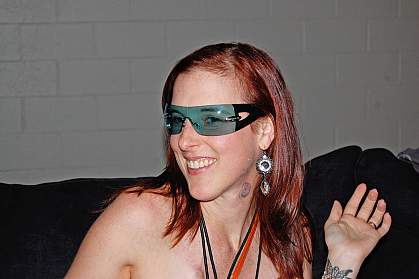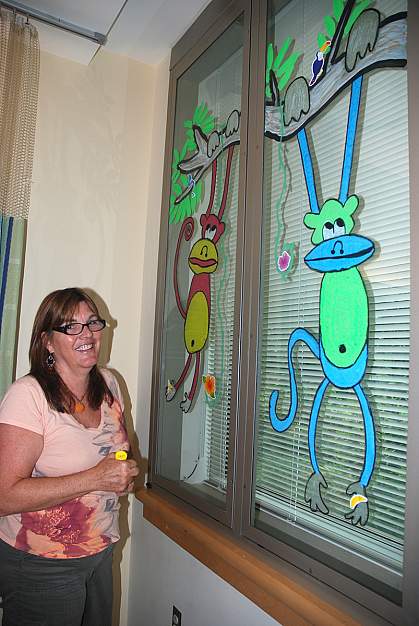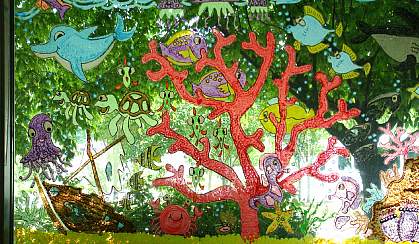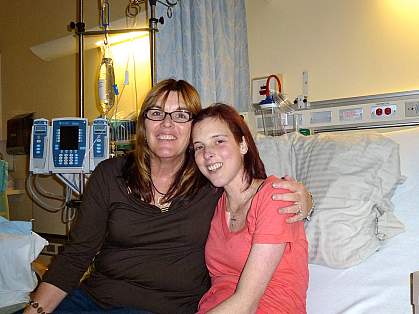You are here
Volunteer Story: Annette (mother of a patient)

There are trees painted on the windows in the Clinical Center—trees with welcoming branches like the arms of an old friend.
These are the creation of special volunteer Annette Weller, a self-taught artist who decorates the pediatric unit with her original work.
Weller is the mother of Lauren Marie Weller Sidorowicz, who received treatment at NIH for Ewing’s sarcoma, a type of cancer. Diagnosed at age 18, Lauren spent 8 years on many different NIH protocols, both pediatric and adult. She passed away on Dec. 14, 2011.
“Lauren had many inpatient stays with surgeries, chemo and radiation,” said Weller. “She was one of the first of the Ewing’s transplants; her sister Lindsay donated stem cells. So this was a home for us. They took us in and wrapped their arms around us. Doctors, nurses, guys parking the cars, the front desk, the people who make the coffee…”
She pauses, paint marker in hand, and asks: “Can you put in there how wonderful everybody is?”
Lauren lived with cancer for 8 years. What’s astonishing is how much she accomplished and how deeply she touched those around her. She donated her hair to Locks of Love, which provides wigs for cancer patients, and volunteered as a counselor with Camp Fantastic, a summer camp for kids with cancer. She was an active participant with Special Love, a group dedicated to helping young people suffering from pediatric cancers. After completing her master’s degree at Frostburg State University, she taught science at Mother Catherine Spalding School in Mechanicsville, Md., and coached volleyball at St. Mary’s Ryken High School in Leonardtown, Md. And she married her college sweetheart, who stuck with her through all her treatments.

Before Lauren passed away, she asked her mother to start a fundraiser to bring the families of pediatric patients to the CC.
“NIH brings the child and one caregiver,” says Weller. “We want to bring ’em all.” So Lauren’s legacy now includes “L-Dub’s Love,” a non-profit group dedicated to assisting and providing resources to families of children receiving cancer treatment.
And Lauren loved music. Along with other patients being treated at the CC, in 2011 she accompanied NIH director Dr. Francis Collins in a special outing to a U2 concert in Baltimore.
“The kids loved her,” says Dr. Lori Wiener, NCI’s director of psychosocial support and research. “Lauren mobilized, energized and inspired so many children with cancer over the years. She would put her own issues to the side…‘Tell me about you, and how are you today,’ is how she started every conversation. She touched so many people along the way with her smile, energy and warmth…She never gave up hope.”
Wiener’s role is to support patients and their families during their time at NIH and beyond. Her clinical research includes patient and family mental health, loss and bereavement, staff wellness and interventions—like art—designed to meet the needs of critically ill children and their families.
“There are no adequate words to describe the pain and suffering when a parent has lost a child,” she says. Yet art can offer a way to express the indescribable. During Lauren’s last inpatient stay, Wiener offered Weller a basket of window paint markers, saying, “Annette, if you are so inclined…”

“I’m not a painter,” says Weller, now retired from the postal service, “but I had this tree in my head. So I said what the heck.”
She painted a glow-in-the-dark tree on the window of Lauren’s room in the CC. With 15 critters in its branches, it was dubbed “the Tree of Life.”
“I thought they would wash it off,” she says.
Instead, it would become the first of many. The staff did not forget Lauren or her mother’s Tree of Life; they had gone through years of changes together, the ups and downs, developmental milestones, birthdays and graduations. After Lauren died, one of the 1NW nurses started a bereavement task force, looking for ways to make the unit more comforting, homelike and interactive for families. She remembered how the kids loved the tree—it made them and their families feel less isolated.
There was real comfort in the image, and Wiener, once a semi-professional photographer, had an eye for that connection. So she contacted Weller and asked if she might be willing to return to NIH as a special volunteer.
“We talked about trees symbolized by [their] branches,” says Wiener, “all the different directions [they] can grow, all that trees can carry.”

With a good friend for support, Weller returned to the CC and, on the window of the room nextdoor to the one where her daughter died, she drew the outline of a new tree. So she didn’t have to feel alone, her friend and Wiener helped by filling it in.
As the project grew, the trees captured the kids’ attention. When a young boy was transferred from “the room with the owl tree” to “the room with the monkey tree,” he wanted the staff to put the owl tree in his new room, says Weller. “So I met with him and placed an owl in the monkey tree. Got a big smile out of him.”
She also met with another child who was preparing for a transplant. “He requested penguins… that was how the penguin tree came about,” she recalls. “I painted it the day before his transplant. He was very sick that day, but was really happy about the window.”
And now, as natural light filters into the rooms, it gives these windows the uplifting beauty of stained glass. This is fitting, because Lauren’s faith was essential to her, says Wiener. “She believed that there would be a tomorrow where she would be joined with those she loved.” Through an advance care planning guide that Lauren helped create, she worked hard to prepare those she loved for life after she was gone. The guide, based on the findings of an NCI clinical protocol, is now available worldwide.
“And she understood why today could be beautiful,” Wiener says.
“Lauren participated in many NIH studies,” she continues. “She helped advance science and perhaps even more importantly, she advanced a dignified way to live with cancer.”
Her mother continues Lauren’s legacy of hope and service. “It’s really cathartic,” she said. “It helps me say goodbye a little bit more every time I do one.”
This page last reviewed on November 20, 2023
